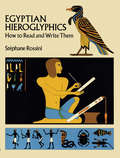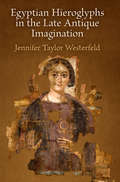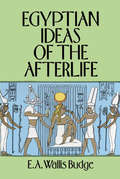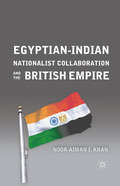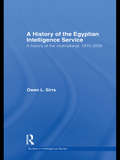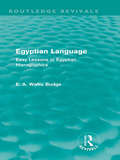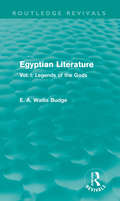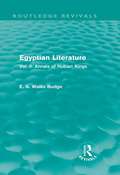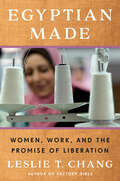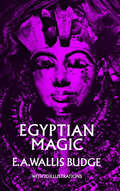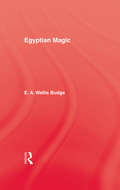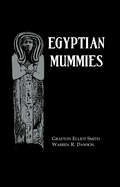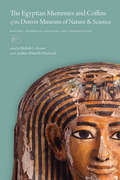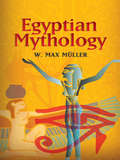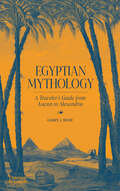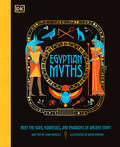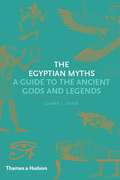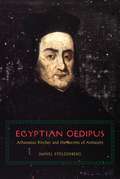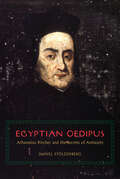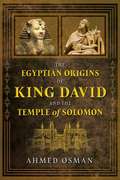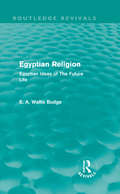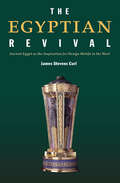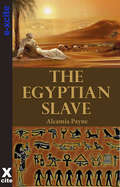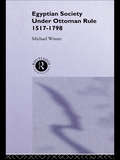- Table View
- List View
Egyptian Hieroglyphics: How to Read and Write Them
by Stephane RossiniClear, easy-to-follow text tells absolute beginners how to transcribe hieroglyphs by presenting and explaining 134 phonetic elements. Included are an explanatory introduction, section on word analysis, newly enlarged pronunciation guide, tables of phonetic and figurative (or determinative) signs, and much more. Unusually large, clear illustrations.
Egyptian Hieroglyphs in the Late Antique Imagination
by Jennifer Taylor WesterfeldThroughout the pharaonic period, hieroglyphs served both practical and aesthetic purposes. Carved on stelae, statues, and temple walls, hieroglyphic inscriptions were one of the most prominent and distinctive features of ancient Egyptian visual culture. For both the literate minority of Egyptians and the vast illiterate majority of the population, hieroglyphs possessed a potent symbolic value that went beyond their capacity to render language visible. For nearly three thousand years, the hieroglyphic script remained closely bound to indigenous notions of religious and cultural identity.By the late antique period, literacy in hieroglyphs had been almost entirely lost. However, the monumental temples and tombs that marked the Egyptian landscape, together with the hieroglyphic inscriptions that adorned them, still stood as inescapable reminders that Christianity was a relatively new arrival to the ancient land of the pharaohs. In Egyptian Hieroglyphs in the Late Antique Imagination, Jennifer Westerfeld argues that depictions of hieroglyphic inscriptions in late antique Christian texts reflect the authors' attitudes toward Egypt's pharaonic past. Whether hieroglyphs were condemned as idolatrous images or valued as a source of mystical knowledge, control over the representation and interpretation of hieroglyphic texts constituted an important source of Christian authority.Westerfeld examines the ways in which hieroglyphs are deployed in the works of Eusebius and Augustine, to debate biblical chronology; in Greek, Roman, and patristic sources, to claim that hieroglyphs encoded the mysteries of the Egyptian priesthood; and in a polemical sermon by the fifth-century monastic leader Shenoute of Atripe, to argue that hieroglyphs should be destroyed lest they promote a return to idolatry. She argues that, in the absence of any genuine understanding of hieroglyphic writing, late antique Christian authors were able to take this powerful symbol of Egyptian identity and manipulate it to serve their particular theological and ideological ends.
Egyptian Ideas of the Afterlife
by E. A. BudgeIn this volume, a noted Egyptologist offers a concise, scholarly exposition of Egyptian belief in Osiris, god of the resurrection; other "gods" of the Egyptians; the judgment of the dead and the resurrection; and immortality. Also, the meaning of the afterlife for ancient Egyptians and its ramifications for Egyptian society.
Egyptian-Indian Nationalist Collaboration and the British Empire
by Noor-Aiman I. KhanAn examination of the collaboration between Egyptian and Indian nationalists against the British Empire, this book argues that the basis for Third World or Non-Aligned Movement was formed long before the Cold War.
The Egyptian Intelligence Service: A History of the Mukhabarat, 1910-2009 (Studies in Intelligence)
by Owen L. SirrsThis book analyzes how the Egyptian intelligence community has adapted to shifting national security threats since its inception 100 years ago. Starting in 1910, when the modern Egyptian intelligence system was created to deal with militant nationalists and Islamists, the book shows how the security services were subsequently reorganized, augmented and centralized to meet an increasingly sophisticated array of challenges, including fascism, communism, army unrest, Israel, France, the United Kingdom, conservative Arab states, the Muslim Brotherhood and others. The book argues that studying Egypt’s intelligence community is integral to our understanding of that country’s modern history, regime stability and human rights record. Intelligence studies have been described as the ‘missing dimension’ of international relations. It is clear that intelligence agencies are pivotal to understanding the nature of many Arab regimes and their decision-making processes, and there is no published history of modern Egyptian intelligence in either a European language or in Arabic, though Egypt has the largest and arguably most effective intelligence community in the Arab world. This book will fill a clear gap in the intelligence literature and will be of much interest to students of intelligence studies, Middle Eastern politics, international security and IR in general.
Egyptian Language: Easy Lessons in Egyptian Hieroglyphics (Routledge Revivals)
by E.A. Wallis BudgeSir E. A. Wallis Budge (1857-1934) was Keeper of the British Museum’s department of oriental antiquities from 1894 until his retirement in 1924. Carrying out many missions to Egypt in search of ancient objects, Budge was hugely successful in collecting papyri, statues and other artefacts for the trustees of the British Museum: numbering into the thousands and of great cultural and historical significance. Budge published well over 100 monographs, which shaped the development of future scholarship and are still of great academic value today, dealing with subjects such as Egyptian religion, history and literature. The ancient Egyptians expressed their ideas in writing by means of hieroglyphics, which they used uninterruptedly until the end of the rule of the Ptolemies. Evidence indicates that the hieroglyphic system of writing was brought to Egypt by invaders from north-east or central Asia; they settled somewhere between Memphis on the north and Thebes on the south, and gradually established their civilization, religion and methods of communication. First published in 1910, Egyptian Language provides a simple introduction to the study of Egyptian hieroglyphic inscriptions. Including an account of the decipherment of the hieroglyphic system and the general principles which underlie it, as well as the main facts of ancient Egyptian grammar and illustrative extracts, the book will be of value to students and academics of ancient Egyptian language and culture.
Egyptian Literature: Vol. I: Legends of the Gods (Routledge Revivals)
by E.A. Wallis BudgeSir E. A. Wallis Budge (1857-1934) was Keeper of the British Museum’s department of oriental antiquities from 1894 until his retirement in 1924. Carrying out many missions to Egypt in search of ancient objects, Budge was hugely successful in collecting papyri, statues and other artefacts for the trustees of the British Museum: numbering into the thousands and of great cultural and historical significance. Budge published well over 100 monographs, which shaped the development of future scholarship and are still of great academic value today, dealing with subjects such as Egyptian religion, history and literature. First published in 1912, this work is the first of two volumes which deal explicitly with ancient Egyptian literature. Budge reproduces the most typical literature in hieroglyphic form, with the intention of providing the beginner with a series of books to read alongside translations. They are arranged here with English translations next to the original writing, and are complemented by a detailed introduction which provides a contextual framework for this fascinating material. Also including a number of other texts and a range of detailed images and hieroglyphics, this classic work will be of interest to scholars and students of Ancient Egyptian literature, language and history.
Egyptian Literature: Vol. II: Annals of Nubian Kings (Routledge Revivals)
by E.A. Wallis BudgeSir E. A. Wallis Budge (1857-1934) was Keeper of the British Museum’s department of oriental antiquities from 1894 until his retirement in 1924. Carrying out many missions to Egypt in search of ancient objects, Budge was hugely successful in collecting papyri, statues and other artefacts for the trustees of the British Museum: numbering into the thousands and of great cultural and historical significance. Budge published well over 100 monographs, which shaped the development of future scholarship and are still of great academic value today, dealing with subjects such as Egyptian religion, history and literature. First published in 1912, this work is the second of two volumes which deal explicitly with ancient Egyptian literature. This volume contains Egyptian texts, with English translations, taken from the Seven Stelae which originally stood in a group at the great temple at Gebel Barkal. The texts describe areas of the history of Egypt, including the principal events which took place in the kingdom of Napata from c.750 B.C. to 500 B.C. Also including a number of other texts and a range of detailed images and hieroglyphics, this classic work will be of interest to scholars and students of Ancient Egyptian literature, language and history.
Egyptian Made: Women, Work, and the Promise of Liberation
by Leslie T. ChangAn incisive exploration of women and work, showing how globalization&’s promise of liberation instead set the stage for repression—from the acclaimed author of Factory Girls&“Exhaustively reported and researched, Egyptian Made takes us halfway across the world and inside the intimate lives of women caught between tradition and independence.&”—Monica Potts, New York Times bestselling author of The Forgotten GirlsWhat happens to the women who choose to work in a country struggling to reconcile a traditional culture with the demands of globalization? In this sharply drawn portrait of Egyptian society—deepened by two years of immersive reporting—Leslie T. Chang follows three women as they persevere in a country that throws up obstacles to their progress at every step, from dramatic swings in economic policy to conservative marriage expectations and a failing education system.Working in Egypt&’s centuries-old textile industry, Riham is a shrewd businesswoman who nevertheless struggles to attract workers to her garment factory and to compete in the global marketplace. Rania, who works on a factory assembly line, attempts to climb to a management rank but is held back by conflicts with co-workers and the humiliation of an unhappy marriage. Her colleague Doaa, meanwhile, pursues an education and independence but sacrifices access to her own children in order to get a divorce.Alongside these stories, Chang shares her own experiences living and working in Egypt for five years, seeing through her own eyes the risks and prejudices that working women continue to face. She also weaves in the history of Egypt&’s vaunted textile industry, its colonization and independence, a century of political upheaval, and the history of Islam in Egypt, all of which shaped the country as it is today and the choices available to Riham, Rania, and Doaa. Following each woman&’s story from home and work, Chang powerfully observes the near-impossible balancing act that Egyptian women strike every day.
Egyptian Magic
by E. A. BudgeFor millennia, Egypt, the dark land, has been considered the home of magic. The feats of her priests and magicians were renowned throughout the ancient world, from the simplest legerdemain (according to present interpretation) to the heights of necromancy and sorcery. Even their most severe critics, the ancient Hebrews, admitted the power of Egyptian magic. In the famous sorcerers' duel between Moses and Egyptian priests before Pharaoh, the Egyptians were almost as skilled as Moses.This well-known study of ancient Egyptian magic, by E. A. Wallis Budge, long curator of Egyptian antiquities at the British Museum, sums up everything that is known about the wonder-working of ancient Egypt. After a general discussion of the role of magic in Egyptian religion proper — Dr. Budge covers the powerful amulets that warded off evil spirits; the scarabs of immortality; the use of wax images and spirit placements; magical pictures and formulas; magic via the secret name; magic of sounds; rituals; curses; destruction of hostile magic; determination of fortunate dates, and many of the other practices of the ancient Nile dwellers.Dozens of magic formulas are given in full — both in the original Egyptian sounds, as far as they can be recreated — and in English; dozens of excerpts are also given from the magical papyroi, tomb inscriptions, and other sources. Many wonderful tales are told in these Egyptian stories; mind control, enforcing will upon animals, suspended animation, calling up the dead, finding ancient books of incredible magical power, and other miraculous events that we may or may not believe.
Egyptian Magic (Egypt Ser.)
by E. A. Wallis BudgeFirst published in 2002. Routledge is an imprint of Taylor & Francis, an informa company.
Egyptian Mummies
by Grafton Elliot Smith Warren R. DawsonFirst published in 2002. Routledge is an imprint of Taylor & Francis, an informa company.
The Egyptian Mummies and Coffins of the Denver Museum of Nature & Science: History, Technical Analysis, and Conservation
by Michele L. Koons Caroline Arbuckle MacLeodIn the 1970s and 1980s, the Denver Museum of Nature & Science acquired two ancient Egyptian mummies and three coffins. The mummies are the remains of two women who lived in an unknown locale in ancient Egypt. They both died in their thirties and have now been subjected to a number of unpublished scientific and unscientific analyses over the years. In 2016, as DMNS prepared to update its Egyptian Hall, staff scientists decided to reexamine the mummies and coffins using innovative, inexpensive, and accessible techniques. This interdisciplinary volume provides a history of the mummies’ discovery and relocation to Colorado. It guides the reader through various analytical techniques, detailing past research and introducing new data and best practices for future conservation efforts. The new analysis includes more accurate radiocarbon dating, fully comprehensive data from updated CT scans, examples of Egyptian blue and yellow pigments on the coffins uncovered by non-invasive x-ray fluorescence, unprecedented analysis of the coffin wood, updated translations and stylistic analysis of the text and imagery on the coffins, gas chromatography of the paints and resins, linen analysis, and much more. The Egyptian Mummies and Coffins of the Denver Museum of Nature & Science provides replicable findings and consistent terminology for institutions performing holistic studies on extant museum collections of a range of material types. It will add substantially to what we know about the effective conservation of Egyptian mummies and coffins. Contributors: Christopher H. Baisan, Hans Barnard, Bonnie Clark, Pearce Paul Creasman, Farrah Cundiff, Jessica M. Fletcher, Kari L. Hayes, Kathryn Howley, Stephen Humphries, Keith Miller, Vanessa Muros, Robyn Price, David Rubinstein, Judith Southward, Jason Weinman
Egyptian Mummies: Made to Last (Fountas & Pinnell Classroom, Guided Reading)
by Jill RubalcabaNIMAC-sourced textbook. Preserving the Dead. Jackals dug them up and gnawed on them. Bacteria rotted them. Yet many bodies of ancient Egyptians still survive today.
Egyptian Mythology
by F. Max MüllerThe complexities of Egyptian mythology — its gods, sun and animal worship, myths, and magical practices — are explored. The development of religious doctrines, as portrayed in art and in literature, also receives a close inspection. Magnificently illustrated, the text contains 232 figures that clarify ancient beliefs and customs.
Egyptian Mythology: A Traveler's Guide from Aswan to Alexandria
by Garry J. ShawThis unique approach to Egyptian mythology takes readers on a tour up the Nile, stopping at the most famous monuments and vividly retelling the myths connected to each site. Join Egyptologist Garry J. Shaw on an entertaining tour up the Nile, through a beautiful and fascinating landscape populated with a rich mythology: the stories of Horus, Isis, Osiris, and their enemies and allies in tales of vengeance, tragedy, and fantastic metamorphoses. Shaw retells these stories with his characteristic wit, and reconnects them to the temples and monuments that still stand today, offering a fresh look at the most visited sites of Egypt. The myths of ancient Egypt have survived in fragments of ancient hymns and paintings on the walls of tombs and temples, spells inked across coffins, and stories scrawled upon scrolls. Illustrations throughout bring to life the creation of the world and the nebulous netherworld; the complicated relationships between fickle gods, powerful magicians, and pharaohs; and eternal battles on a cosmic scale. Shaw’s evocative descriptions of the ancient ruins will transport readers to another landscape—including the magnificent sites of Dendera, Tell el-Amarna, Edfu, and Thebes. At each site, they will discover which gods or goddesses were worshipped there, as well as the myths and stories that formed the backdrop to the rituals and customs of everyday life. Each chapter ends with a potted history of the site, as well as tips for visiting the ruins today. Egyptian Mythology is the perfect companion to the myths of Egypt and the gods and goddesses that shaped its ancient landscape.
Egyptian Myths
by Jean MenziesA beautifully illustrated collection of 20 ancient Egyptian myths retold for children aged 7-9.Delve into a world of monstrous creatures, magical spells, and warring gods in this thrilling compendium of ancient Egyptian myths. With 20 exciting tales alongside fascinating historical information, this is a must-have introduction for young readers interested in one of the world&’s great early civilizations. From the creation of the world to the first pharaohs, this book charts the full sweep of ancient Egyptian mythology, revealing fascinating elements of culture and religion along the way. The enthralling stories introduce mighty gods and wicked villains, while a handy reference section is packed with information about the ancient Egyptians themselves. Learn how Ra fought daily battles to make the Sun rise, how trouble-making Set brought chaos to the kingdom, and how Osiris became the first mummy. Perfect for children aged 7 to 9, this collection contains more than 20 enthralling new retellings of favorite myths as well as some you might not have heard before.Encourage your children to explore: Over 20 fascinating Egyptian myths, covering famous classics and lesser known storiesStriking illustrations by multi-award winning artist Katie PonderStunning gold foil on the cover A handy pronunciation guide listing all difficult-to-pronounce names for the reader&’s convenienceKey reference spreads combining the appeal of a story collection with key reference informationIt&’s time to dive into the Duat underworld, ride into the sky on the back of the heavenly cow, and discover the secrets of the pharaoh&’s tombs. Egyptian Myths brings the world of ancient Egypt to life and is the perfect gift for children who love history and mythology. At DK, we believe in the power of discovery. So why not complete the collection!Discover stories from Ancient Greece like never before with Greek Myths, and uncover action-packed tales of extraordinary creatures and compelling gods, goddesses and more with Norse Myths.
The Egyptian Myths: A Guide to the Ancient Gods and Legends
by Garry J. ShawAn authoritative guide to the Egyptian myths that sheds new light on an ancient way of understanding the world This survey of Egyptian mythology explores how the ancient Nile-dwellers explained the world around them. It delves into the creation and evolution of the world and the reigns of the gods on earth, before introducing us to the manifestations of Egypt's deities in the natural environment; the inventive ways in which the Egyptians dealt with the invisible forces all around them; and their beliefs about life after death. Through his engaging narrative, Garry Shaw guides us through the mythic adventures of such famous deities as Osiris, the god murdered by his jealous brother Seth; the magical and sometimes devious Isis, who plotted to gain the power of the sun god Re; and Horus, who defeated his uncle Seth to become king of Egypt. He also introduces us to lesser known myths, such as the rebellions against Re; Geb's quest for Re's magical wig; and the flaying of the unfortunate god Nemty. From stars and heavenly bodies sailing on boats, to the wind as manifestation of the god Shu, to gods, goddesses, ghosts, and demons--beings that could be aggressive, helpful, wise, or dangerous--Shaw goes on to explain how the Egyptians encountered the mythological in their everyday lives.
Egyptian Oedipus: Athanasius Kircher and the Secrets of Antiquity
by Daniel StolzenbergA contemporary of Descartes and Newton, Athanasius Kircher, S. J. (1601/2-80), was one of Europe's most inventive and versatile scholars in the baroque era. He published more than thirty works in fields as diverse as astronomy, magnetism, cryptology, numerology, geology, and music. But Kircher is most famous--or infamous--for his quixotic attempt to decipher the Egyptian hieroglyphs and reconstruct the ancient traditions they encoded. In 1655, after more than two decades of toil, Kircher published his solution to the hieroglyphs, Oedipus Aegyptiacus, a work that has been called "one of the most learned monstrosities of all times. " Here Daniel Stolzenberg presents a new interpretation of Kircher's hieroglyphic studies, placing them in the context of seventeenth-century scholarship on paganism and Oriental languages. Situating Kircher in the social world of baroque Rome, with its scholars, artists, patrons, and censors, Stolzenberg shows how Kircher's study of ancient paganism depended on the circulation of texts, artifacts, and people between Christian and Islamic civilizations. Along with other participants in the rise of Oriental studies, Kircher aimed to revolutionize the study of the past by mastering Near Eastern languages and recovering ancient manuscripts hidden away in the legendary libraries of Cairo and Damascus. The spectacular flaws of his scholarship have fostered an image of Kircher as an eccentric anachronism, a throwback to the Renaissance hermetic tradition. Stolzenberg argues against this view, showing how Kircher embodied essential tensions of a pivotal phase in European intellectual history, when pre-Enlightenment scholars pioneered modern empirical methods of studying the past while still working within traditional frameworks, such as biblical history and beliefs about magic and esoteric wisdom.
Egyptian Oedipus: Athanasius Kircher and the Secrets of Antiquity
by Daniel StolzenbergA contemporary of Descartes and Newton, Athanasius Kircher, S. J. (1601/2–80), was one of Europe’s most inventive and versatile scholars in the baroque era. He published more than thirty works in fields as diverse as astronomy, magnetism, cryptology, numerology, geology, and music. But Kircher is most famous—or infamous—for his quixotic attempt to decipher the Egyptian hieroglyphs and reconstruct the ancient traditions they encoded. In 1655, after more than two decades of toil, Kircher published his solution to the hieroglyphs, Oedipus Aegyptiacus, a work that has been called “one of the most learned monstrosities of all times.” Here Daniel Stolzenberg presents a new interpretation of Kircher’s hieroglyphic studies, placing them in the context of seventeenth-century scholarship on paganism and Oriental languages. Situating Kircher in the social world of baroque Rome, with its scholars, artists, patrons, and censors, Stolzenberg shows how Kircher’s study of ancient paganism depended on the circulation of texts, artifacts, and people between Christian and Islamic civilizations. Along with other participants in the rise of Oriental studies, Kircher aimed to revolutionize the study of the past by mastering Near Eastern languages and recovering ancient manuscripts hidden away in the legendary libraries of Cairo and Damascus. The spectacular flaws of his scholarship have fostered an image of Kircher as an eccentric anachronism, a throwback to the Renaissance hermetic tradition. Stolzenberg argues against this view, showing how Kircher embodied essential tensions of a pivotal phase in European intellectual history, when pre-Enlightenment scholars pioneered modern empirical methods of studying the past while still working within traditional frameworks, such as biblical history and beliefs about magic and esoteric wisdom.
The Egyptian Origins of King David and the Temple of Solomon
by Ahmed OsmanAn investigation into the real historical figure of King David and the real location of the Temple of Solomon • Identifies King David as Pharaoh Tuthmosis III of the 18th Dynasty and David’s son Solomon as Pharaoh Amenhotep, Tuthmosis’s successor • Shows how the Temple of Solomon described in the Bible corresponds with the Mortuary Temple of Luxor in Egypt • Explains how David was not a descendant of Isaac but his father and how biblical narrators changed the original story of Abraham and Isaac to hide his Egyptian identity During the last two centuries, thousands of ancient documents from different sites in the Middle East have been uncovered. However, no archaeological discovery speaks of King David or Solomon, his son and successor, directly or in directly. Was King David a real person or a legend like King Arthur? Proposing that David was a genuine historical figure, Ahmed Osman explores how his identity may be radically different than what is described in religious texts. Drawing on recent archaeological, historical, and biblical evidence from Egypt, Osman shows that David lived in Thebes, Egypt, rather than Jerusalem; that he lived five centuries earlier than previously thought, during the 15th rather than the 10th century B.C.; and that David was not a descendant of Isaac but was, in fact, Isaac’s father. The author also reveals David’s true Egyptian identity: Pharaoh Tuthmosis III of the 18th Dynasty. Confirming evidence from rabbinic literature that indicates Isaac was not Abraham’s son, despite the version provided in Genesis, Osman demonstrates how biblical narrators replaced David with Abraham the Hebrew to hide the Egyptian identity of Isaac’s father. He shows how Egyptian historical and archaeological sources depict figures that match David’s and Solomon’s known characteristics in many ways, including accounts of a great empire between the Euphrates and the Nile that corresponds with David’s empire as described in the Bible. Extending his research further, the author shows that King Solomon, King David’s son, corresponds in reality to Pharaoh Amenhotep, successor of Tuthmosis III, the pharaoh who stands out in the dynastic history of Egypt not only for his peaceful reign but also as the builder of the Temple of Luxor and the famed Mortuary Temple at Luxor, which matches the biblical descriptions of Solomon’s Temple. Unveiling the real history behind the biblical story of King David, Osman reveals that the great ancestor of the Israelites was, in fact, Egyptian.
Egyptian Religion: Egyptian Ideas of The Future Life (Routledge Revivals)
by E.A. Wallis BudgeSir E. A. Wallis Budge (1857-1934) was Keeper of the British Museum’s department of oriental antiquities from 1894 until his retirement in 1924. Carrying out many missions to Egypt in search of ancient objects, Budge was hugely successful in collecting papyri, statues and other artefacts for the trustees of the British Museum: numbering into the thousands and of great cultural and historical significance. Budge published well over 100 monographs, which shaped the development of future scholarship and are still of great academic value today, dealing with subjects such as Egyptian religion, history and literature. First published in 1899 as part of the Egypt and Chaldaea series, Egyptian Religion explores the principal ideas and beliefs held by the ancient Egyptians with regard to the doctrine of the resurrection and the future life. Although no systematic account dealing solely with this doctrine has been discovered, the Book of the Dead and various other religious texts from which this work is derived reflect ancient Egyptian beliefs, ideals and superstitions. Wallis Budge explores the Gods of the Egyptians and the themes of resurrection and immorality in a classic work, of great significance to students and scholars with an interest in ancient Egyptian and Middle Eastern history and religion.
The Egyptian Revival: Ancient Egypt as the Inspiration for Design Motifs in the West
by James Stevens CurlIn this beautifully illustrated and closely argued book, a completely updated and much expanded third edition of his magisterial survey, Curl describes in lively and stimulating prose the numerous revivals of the Egyptian style from Antiquity to the present day. Drawing on a wealth of sources, his pioneering and definitive work analyzes the remarkable and persistent influence of Ancient Egyptian culture on the West. The author deftly develops his argument that the civilization of Ancient Egypt is central, rather than peripheral, to the development of much of Western architecture, art, design, and religion. Curl examines: the persistence of Egyptian motifs in design from Graeco-Roman Antiquity, through the Medieval, Baroque, and Neo-Classical periods rise of Egyptology in the nineteenth and twentieth-century manifestations of Egyptianisms prompted by the discovery of Tutankhamun’s tomb various aspects of Egyptianizing tendencies in the Art Deco style and afterwards. For students of art, architectural and ancient history, and those interested in western European culture generally, this book will be an inspiring and invaluable addition to the available literature.
The Egyptian Slave
by Alcamia PayneThe Egyptian Slave is an erotic short story by Alcamia Payne with gay, historical and Dom/sub themesMem, favourite of the pharaoh, has one problem, he seems to have lost his mojo. One day, he gives in to impetuosity and buys a new slave girl, Toomela at the slave market. For some reason boyish Toomela excites Mem, but he can’t think why, especially since she seems to irritate him. However, when Mem decides to indulge himself with the girl he gets more than he bargains for, as Toomela exposes her dark and erotic soul and turns out to be a boy. It seems at last, Mem has found the answer to all of his sexual fantasies.
Egyptian Society Under Ottoman Rule, 1517-1798
by Michael WinterMichael Winter's book presents a panoramic view of Ottoman Egypt from the overthrow of the Mamluk Sultanate in 1517 to Bonaparte's invasion of 1798 and the beginning of Egypt's modern period. Drawing on archive material, chronicle and travel accounts from Turkish, Arabic, Hebrew and European sources as well as up-to-date research, this comprehensive social history looks at the dynamics of the Egyptian-Ottoman relationship and the ethnic and cultural clashes which characterised the period. The conflicts between Ottoman pashas and their Egyptian subjects and between Bedouin Arabs and the more sedentary population are presented, as is the role of women in this period and the importance of the doctrinal clash of Islam both orthodox and popular, Christianity and Judaism. Winter's broad survey of a complex and dynamic society draws out the central theme of the emergence, from a period of ethnic and religious tension, of an Egyptian consciousness fundamental to Egypt's later development.
